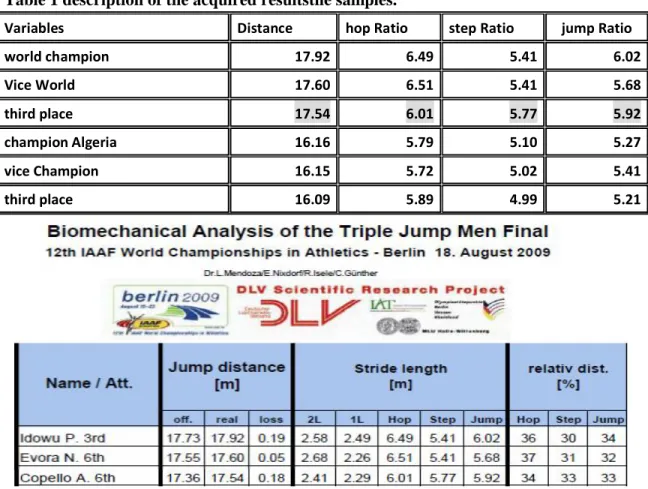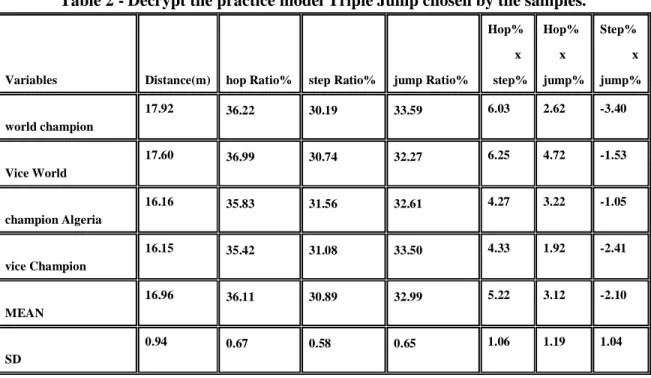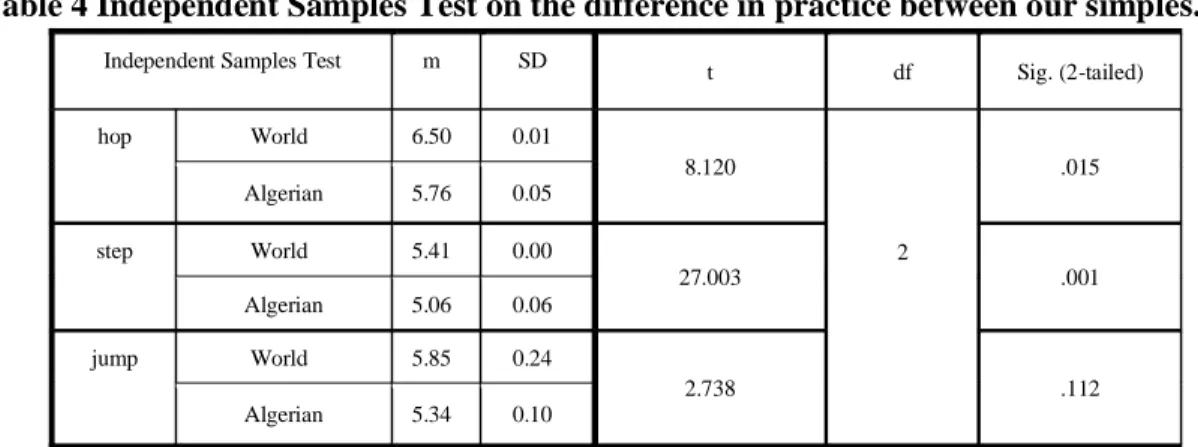See discussions, stats, and author profiles for this publication at: https://www.researchgate.net/publication/282652335
triple jump comparative study results
Conference Paper · July 2015 CITATIONS0
READS377
5 authors, including: Some of the authors of this publication are also working on these related projects: study some biomechanical variables in the steps of supports of the triple jump and their relationship with the digital level View project La fréquence cardiaque dans tous ces états. View project Zerf Mohammed Université Abdelhamid Ibn Badis Mostaganem 73 PUBLICATIONS 43 CITATIONS SEE PROFILE Mokkedes moulay idriss institut d'éducation physique et sportive most… 10 PUBLICATIONS 6 CITATIONS SEE PROFILE Bengoua Ali Mostaganem University 28 PUBLICATIONS 19 CITATIONS SEE PROFILE Bendahmane Mohammed Nasreddine Nasredd… Université Abdelhamid Ibn Badis Mostaganem 6 PUBLICATIONS 10 CITATIONS SEE PROFILE All content following this page was uploaded by Zerf Mohammed on 08 October 2015. The user has requested enhancement of the downloaded file.Conference Proceedings
July, 2015
Hokkaido Japan
ISBSS
International Symposium on Business and Social
Sciences
BREFM
International Business, Economics, Finance and
Management Conference
ISBSS
International Symposium on Business and Social Sciences ISBN 978-986-87417-9-9
BREFM
International Business, Economics, Finance and Management Conference ISBN 978-986-90827-0-9
583
ISBSS-4617
The Impact of the Techniques and Tactics Appropriate
Phase Triple Jump and Their Relationships with the Finale Results
Zerf Mohammed*, Mokkedes moulay idriss , Bengoua Ali ,Bendahmane Med Nasreddin and guebli abdelkader
University of Mostaganem
*
biomeca.zerf@outlook.com
Abstract
The purposes of this study were to describe and compare the techniques used by elite word triple jumper and the Algerian elite time to determine the impact of correct models phases whom allowing the elite to beat world record. The subjects were three world elite and three currently national elite.
In the lack of new technology, the base of our study thinks about
1- Decrypt the practice model and distribution of the phase between our champions (world-national).
2- Compart the relationship of the practice model or style between our champions (world-national).
3- Compare the difference in practice model between our champions (world-national). For that, we have shoes the Analysis of variance and correlation of the distances achieved in
tudent to compare implementation distribution of phases (hop, step and jump) with the results accuses.
Our aim for this research is to:
Using the biomechanics to determine errors and integrated the modern scientific methods into the program monitoring sports.
phrases to improve their performances during training and competitions.
Keywords: phase / techniques OF triple jump. Introduction
The original triple jump as practiced by the Greeks was no more than three long jumps. The regulated triple jump was protected at the end of the XIX century, first by the Irish and then by the Americans. (International association of athletics federation, 2002)
The triple jump was inspire by the ancient Olympic Games and has been a modern Olympics event since the Games' inception in 1896. According to IAAF rules, "the hop shall be made so that an athlete lands first on the same foot as that from which he has taken off; in the step he shall land on the other foot, from which, subsequently, the jump is performed." (IAAF,
584
2013).The current male and female world record holders are Jonathan Edwards of Great Britain, with a jump of 18.29 m (60 ft 0 in), and Inessa Kravets of Ukraine, with a jump of 15.50 m (50 ft 10 in). Both records were set during 1995 World Championships in Gothenburg. (Koski, Rissanen & Tahvanainen, 2004)
Algerian female is 14,98 m (+0,2 m/s) By Baya Rahouli in Meeting Almería 1 juillet 2005 the beast record male Algerian is 16, 92(m) by Lotfi Khaïda Monaco Herculis games in August 7, 1993 (Fédération algérienne, 2014).
The literature review reveals that the triple jump consists of a running approach, 3 take-off phases in which the athlete hops on one foot, lands on the same foot, steps onto the opposite foot, and finally jumps and lands in the sand pit (Miladinov O, Bonov P, 2004) (Abeer Eissa, 2014) and the lengths of the three phases are typically about 39 %: 30 %: 31 % of the total length of the jump for the Russian technique, and 35 %: 29 %: 36% of the total length for the Polish technique (McNab, 1968). ( ALLEN, S.J., KING, M.A. and YEADON, M.R., 2013) mention in his report that the world record performances from 1911 to 1985 a move away from a hop-dominated technique with a small step phase (40-41%:22%:36-38%), towards a hop-dominated Technique with a larger step phase (37-39%:28-30%:31-33%), and latterly towards a jump-dominated technique (34-35%:28-30%:36-37%).
For this reason, our goal is to introduce the biomechanics evaluation before explaining the reason scientific of the absence of the Algerian performance elite in this discipline. By discussing the adoption of the model relationship and the importance of maintaining the distribution ratios applied in the outcome.
In addition, our research analysis the performance of Algerian elites as first part and the second part was to compare their results with the world's elite 2009 to illustrate the importance of the good contribution of the phase jump on the results. Our motive is to highlight the biomechanical assessment for Algerian coaches to plan the choice of the right assessment technique to their athletes.
Material and Methods
For the purposes of analysis, we have calculus the distance of the step phase (the distance of the hop), and step phase (the distance of the step), and the phase jump (the distance of the jump), in two-dimensional (Hay, 1975).
The analysis of the present study was with the software kinovea, on the capture and measured distance of each phase of triple jump as Figure 1.
585
Figure 1. The method chosen to calculate the variables in two-dimensional analysis (Nelia Alfano Moura, Tania Fernandes de Paula Moura, Joao Paulo Borin, 2003)
Our experience was inspires by the study: Triple Jump: Using Quantic Biomechanics to Calculate Centre of Mass,
Vertical and Horizontal Velocity during Triple Jump
Data Collection Subjects:
The subjects were the three-world champion berlin 2009 heir results from the (project by the german atletecs federration, 2009) and for algerien we have made analyses of them performance in similar study
586
Table 1 description of the acquired resultsthe samples.
Variables Distance hop Ratio step Ratio jump Ratio
world champion 17.92 6.49 5.41 6.02 Vice World 17.60 6.51 5.41 5.68 third place 17.54 6.01 5.77 5.92 champion Algeria 16.16 5.79 5.10 5.27 vice Champion 16.15 5.72 5.02 5.41 third place 16.09 5.89 4.99 5.21
We record an error in Table 1 that the results transmitted from the source indicates that the result of the third rider and 17.54 m. something that does not match its Length who offers her 17,862m and 17,682m will be real.
For this reason, our research will be limited on the champion and vice champion (world-national).
In addition
1- the tow national elite that we have Filming with the Protocol/Two motion-picture cameras,
filming at nominal rates of 100 frames per second, were have used to record the performance of the subjects on each trial. These cameras were placed at distances of 19.4 m and 22.1 m from the midline of the triple jump runway, with their optical axes at right angles to this line. The first camera was placed 0.9 m forward (or on the pit side) of the front edge of the board and was used to record the subjects' performances during the hop phase of the triple jump. The second camera was placed 13.0 m forward of the front edge of the board and was used to record performances during the step and jump phases (James G. Hay and John A. Miller, Jr., 1985).
587
track between the runway and each camera. These markers served later as Reference measurement.
Data Reduction
Our cameras were attached to our laptops to record directly into folders prepare in advance for each subject chosen for analysis. The distances of the analyses tests are show in Table the Subject
obtained for each test were phase analysis for each variable and participant.
Data Analysis
The data analysis procedures used in this study consisted of the computation of the means and standard deviations of all the variables identified in the theoretical mode and for which data could be collected, and the computation of the Pearson product-moment correlations between each of these variables and the official distance of the triple jump. To identify important associations among the independent variables, correlations was also computed between them variables found to be significantly related to the official distance of the jump and the other variables identified in Figure 1.
Results
1-Decrypt the practice model and distribution of the phase bit win our champions (world-national).
Table 2 - Decrypt the practice model Triple Jump chosen by the samples.
Variables Distance(m) hop Ratio% step Ratio% jump Ratio%
Hop% x step% Hop% x jump% Step% x jump% world champion 17.92 36.22 30.19 33.59 6.03 2.62 -3.40 Vice World 17.60 36.99 30.74 32.27 6.25 4.72 -1.53 champion Algeria 16.16 35.83 31.56 32.61 4.27 3.22 -1.05 vice Champion 16.15 35.42 31.08 33.50 4.33 1.92 -2.41 MEAN 16.96 36.11 30.89 32.99 5.22 3.12 -2.10 SD 0.94 0.67 0.58 0.65 1.06 1.19 1.04
588
Through the results in Table 1, showing that all of the samples tend to apply the small step phase model. Where the hops stage is the largest of the Polish distribution model (McNab, 1968)the nearest that any of the simple came to the 39%: 30%: 31% ratio of McNab The mean ratio of the phase distances for the means world championship subjects was 36.60%: 30.46%: 32.93% and For the Algerian elites was 35.11%: 32.23%: 33.18%. (S.J. Allen, M.A. King, and M.R. Yeadon, 2013)
. In addition, the model of our simple Ranged Between ratio (37%:30-31%:32-33%).
From the above we can conclude that Phase hop is long then the phase step how confirm the shows of small phase as technical model.
1-Compart the relationship of the practice model or style between our champions (world-national).
Table 3 those relations with the results achieved.
Correlations World hop World step World jump
Algerian hop Pearson Correlation 1.000**
Sig. (2-tailed) .
N 2
Algerian step Pearson Correlation 1.000**
Sig. (2-tailed) .
N 2
Algerian jump Pearson Correlation 1.000**
Sig. (2-tailed) .
N 2
**Correlation is significant at the 0.01 level (2-tailed).
Through Table 3 shows that the variables have a high correlationpositive at 0.01 and very significant relationship
Based on that relationship we can confirm that simples applied the small step model where the long hop must covered the biggest jump distance with small phase step distance.
589
Table 4 Independent Samples Test on the difference in practice between our simples.
Independent Samples Test m SD t df Sig. (2-tailed) hop World 6.50 0.01 8.120 2 .015 Algerian 5.76 0.05 step World 5.41 0.00 27.003 .001 Algerian 5.06 0.06 jump World 5.85 0.24 2.738 .112 Algerian 5.34 0.10
Through the results in Table 2, show there is a statistically significant difference in favor the world champions in all comparisons except the jump phase, although the mean is in the interest of world champions. This Deference explains the good mastery of technique and
As for the comments on the application of this model, we find that the world champions they are the best because they respect more than the Algerian elites, the modality technically of
These findings are consistent with results ( ALLEN, S.J., KING, M.A. and YEADON, M.R., 2013) Which confirms the optimization of Large vertical velocities in the hop phase resulted in longer hop phases, and shorter step phases, how conclude that the hop-domination techniques is overall, whereas smaller vertical velocities led to larger step phases and balanced model or step-dominated techniques.
Discussion
The study showed that the small step phase model is the most used by athletes or our samples were the hop-dominated.
Our prediction basis that we found the majority of respondents focus on the hop phase to achieve long distance greater distance.
This study are consistent with results (James G. Hay and John A. Miller, Jr., 1985) that produced shorter hop distances than jump distances (Polish technique).
The variance in lengths and ratios of distances during the performance phases (hop, step, and jump) from the champions of world and current national elites was related to the impact of the technics and tactics appropriate by the athlete distribution of phases on the results of the triple jump event.
that beer Elisa clear by the change in the influential bio mechanic indicator values (horizontal velocity loss, vertical velocity, take-off angels, time of braking and pushing) and instability of skillful performance of competition.
590
As for the comments on the application of this model, we find that the world champions they are the best because they maintain the distribution ratios in the phase step Unlike the Algerians. That (K. Dziewiecki, Z. Mazur, and W. Blajer, 2013) Indict in the distinct phases must be learned and practiced to combine them in one successful (long distance) event. Improving the final speed horizontal ideal for the athlete and Condition not to lose control of the technique and influence in achievement (Schexnayder, Irving, 2006)
Conclusion
From the purposes of this study, that goal to describe and compare the techniques used by elite word triple jumper 2009 and the Algerian elite time we have determine the impact of application of modality model phases whom allowing the elite to beat world record.
For:
Decrypt the practice model and distribution of the phase between our champions (world-national).
All simples practice the small step as model in the distribution of the phase. For:
2-Compart the relationship of the practice model or style between our champions (world-national).
The coloration is significate how confirm the same technique practice by de simples. For:
Compare the difference in practice between our champions (world-national).
The world champions are the best in adaptation of this technique and that tactic are sow respect to the exigent
of good practiced of this model
Our aim or our recommendation:
For the national elites and their technical steps:
Using the biomechanics to determine errors in practice the theoretical models of the sports tricks.
Integrated the modern scientific methods into the program monitoring sports.
Respect the modality distribution of efforts in model small phrases to improve their performances.
References
1. ALLEN, S.J., KING, M.A. and YEADON, M.R. ( 2013). Trade-o s between horizontal and vertical velocities during triple jumping and the e ect on phase distances. Journal of
Biomechanics, 979-983.
2. Abeer Eissa. (2014). Biomechanical Evaluation of the Phases of the Triple Jump Take-Off in a Top Female Athlete. Journal of Human Kinetics, 29 35.
591
3. Ahcenneahmed Zerfmohammed . (2015). A study of some mechanical Focal stages in the triple jump and them Relationship with performance. THE 1ST INTERNATIONAL
CONGRESS OF I3SAW, 68.
4. Fédération algérienne. (2014, avril 19). Records d'Algérie d'athlétisme. Récupéré sur fr.wikipedia.org: fr.wikipedia.org/wiki/Records_d'Algérie_d'athlétisme
5. IAAF. (2013, 08 18). Competition Rules 2012-2013. International Association of Athletics Federations, http://www.iaaf.org, MONACO.
6. international association of atlithics fedration. ( 2002, JUL 01).
www.iaaf.org/news/news/triple-jump-introduction. Récupéré sur www.iaaf.org: www.iaaf.org/news/news/triple-jump-introduction
7. James G. Hay and John A. Miller, Jr. (1985). Techniques Used in the Triple Jump (Vol. 1). INTERNATIONAL JOURNAL OF SPORT BIOMECHANICS 1,.
8. K. Dziewiecki, Z. Mazur, and W. Blajer. (2013). ASSESSMENT OF EXTERNAL AND INTERNAL LOADS IN THE TRIPLE JUMP VIA INVERSE DYNAMICS SIMULATION. Biol Sport., 103 109.
9. Koski, Rissanen & Tahvanainen. (2004, (2004). Antiikin urheilu. Olympian kentiltä Rooman areenoille. [The Sports of Antiquity. From the Fields of Olympia to Roman Arenas.] Jyväskylä: Atena Kustannus Oy. ISBN 951-796-341-6). The Sports of Antiquity.
From the Fields of Olympia to Roman Arenas. Soviet Union: ISBN 951-796-341-6.
10. Miladinov O, Bonov P. (2004). Individual approach in improving the technique of triple jump for women. New Studies in Athletics, 27 36.
11. Nelia Alfano Moura, Tania Fernandes de Paula Moura, Joao Paulo Borin. (2003).
Approach speed and performance in the horizontal jumps. IAAF/NSA.
12. project by the german atletecs federration. (2009). biomechanics report wc berlin 2009
triple. german: project by the german atletecs federration.
13. S.J. Allen, M.A. King, and M.R. Yeadon. ( 2013). Trade-offs between horizontal and vertical velocities during triple jumping and the effect on phase distances. Journal of
Biomechanics, 979-983.
14. Schexnayder, Irving. (2006). Mechanics of the Jump Approach. (Journal Modern
Athlete and Practical Coaching, 14.
View publication stats View publication stats




